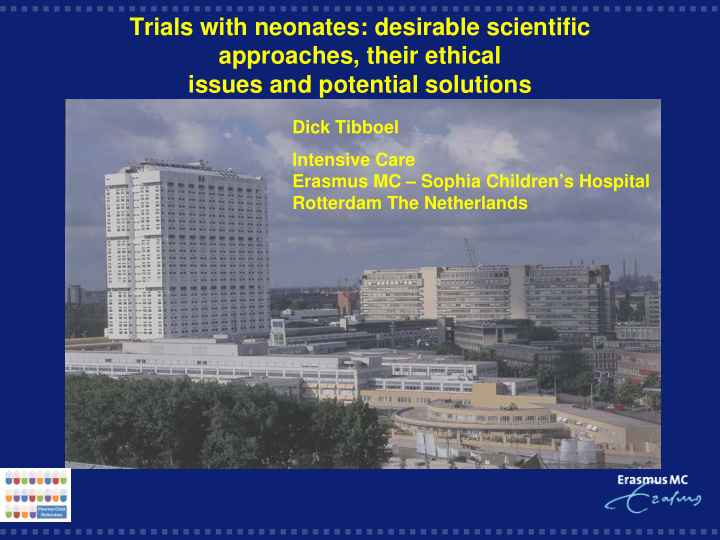



Trials with neonates: desirable scientific approaches, their ethical issues and potential solutions Dick Tibboel Intensive Care Erasmus MC – Sophia Children’s Hospital Rotterdam The Netherlands
Children in the intensive care: - Are generally acutely ill - Are treated with a curative intention - Often with drugs used off-label - Majority under the age of three
HYPOTHESIS It is more unethical not to perform trials in children than to continue prescribing off-label and unlicensed drugs in children.
Critical Care Trials - Trial design - Selection of experimental subjects and controls - Outcome measures - Bias - Sample size calculation - Interpretation of results Crit Care Med 2010;38:1882-1889
Critical Care Trials Crit Care Med 2010;38:1882-1889
Clark RH, Bloom BT, Spitzer AR, Gerstmann DR. Reported medication use in the neonatal intensive care unit: data from a large national data set. Pediatrics 2006;117(6):1979-87
Neonatal pain studies as a model system It’s an important research area due to: - High incidence of pain in critically ill children around the world - Most drugs are used off label and/or unlicensed - Clinical effects are unpredictable even of classical drugs as paracetamol and opioids - Major concern about cell biological effects of the developing central nervous system - Lack of properly designed studies on long term effects
European Journal of Pain (2010)
European Journal of Pain (2010)
Methods
Innovative clinical trial design for pediatric therapeutics Performing clinical trials in children is challenging and is limited by: 1) low study consent rates for parents of vulnerable infants; 2) limited blood volume available to conduct PK studies; 3) lack of pediatric population PK/PD analysis expertise; 4) difficulties associated with blood sampling timing; and 5) the relative absence of microanalytical techniques sufficiently sensitive so as to enable accurate determination of drug concentration from very small volume specimens.
Innovative clinical trial design for pediatric therapeutics Improving the field of PK trials in children: • - multiple-drug assays • - dried blood spot sampling (DBS)
Innovative clinical trial design for pediatric therapeutics Potential advantages of blood spot sampling - -low sample volume - -minimal personnel training - -no sample processing (sample is collected as is at - the patient bedside) - -room temperature storage - -simple bioanalytical analysis.
Innovative clinical trial design for pediatric therapeutics An opportunistic study is one where a child is receiving an off-patent or understudied therapeutic as part of standard of care and, after informed consent, investigators collect PK samples - at the time of routine laboratory draws - use scavenged samples - collect a low number (sparse sampling) - low volume samples
Innovative clinical trial design for pediatric therapeutics Other advantages of opportunistic studies include enrollment of: - - the population of interest - - intensive care patients with comorbid conditions - - children with many concomitant medications that - might affect PK parameters - - subtypes of pediatric populations - - pediatric patients presenting during “disaster” - situations.
CPT 2011; 90; 727-731
Cabana MD et al. JAMA 1999;282:1458-1465
Lies in speed of recruitment Van Dijk M et al. 2005;6:203-210
Ethical Issues in drug trials in children - - What information is provided - - What is the role of trust, dependency, altruism, - therapeutic misconception, hope, understanding - and loyalty - - How should researchers deal with seemingly intuitive - dissent - Is stimulation of motivated consent ethically acceptable.
The informed consent process and understanding information - - Randomization - - Information overload - - Difficulties in remembering information - - Emotional constraint - Motivation to participate in research
Motivations of minors and their parents in clinical trials is related to: - Their personal interests in research participation - Practical issues in the informed consent process - - Personal characteristics such as age and nature of - illness.
Therapeutic Plasma Concentration
Reade MC et al. Crit Care Med 2010;38:1882-1889 Sung NS et al. JAMA 2003;289:1278-1287
Recommend
More recommend